British Toy Companies : CHAD VALLEY TOYS
CHAD VALLEY TOYS
This long established British toy company has its roots set in a stationery business set up by Joseph and Alfred Johnson (Johnson Bros.) in 1860 on George Street, in Birminghams’ city centre although its origins date back even further to a printing and book binding business set up by their father Anthony Bunn Johnson sometime around 1820.
In 1897 the company relocates to a new purpose built premises in Rose Road, Harborne, a district of Birmingham,  a mere 3 miles from the city centre close to the Chad Brook and adjacent to
a mere 3 miles from the city centre close to the Chad Brook and adjacent to
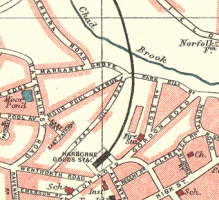 ..
..
.
.
.
.
.
.
.
.a branch-line railway. This railway line brought raw materials to the site with most of the toys produced leaving by the same route. The firm now trading as Johnson Bros. (Harborne) Ltd., making stationers’ sundries and cardboard games and their new factory was known as The Chad Valley Works, named after the nearby stream. They later took the name of Chad Valley as their registered trademark and the building was to remain as the company headquarters for over seventy years.
With the outbreak of the First World War in 1914 toys and games were no longer being  imported giving a boost to the British toy industry and Johnson Bros. seized the opportunity, despite wartime restrictions, to expand its range of cardboard games and simple toys. A year later in 1915 the company was producing its first soft toys, a range of traditional plush Teddy Bears with jointed limbs and by 1916 it was to patent a machine for stuffing these soft toys.
imported giving a boost to the British toy industry and Johnson Bros. seized the opportunity, despite wartime restrictions, to expand its range of cardboard games and simple toys. A year later in 1915 the company was producing its first soft toys, a range of traditional plush Teddy Bears with jointed limbs and by 1916 it was to patent a machine for stuffing these soft toys.
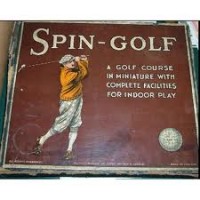 In these early days the companys aim was to complement the range of paper and card based products, which had been born out of their printing business, with more ambitious toys using different materials however a strong emphasis on the printed word remained and at a time when it was unusual for most ‘ordinary’ children to be given toys it was little wonder that output was targeted squarely towards affluent families with their well educated children.
In these early days the companys aim was to complement the range of paper and card based products, which had been born out of their printing business, with more ambitious toys using different materials however a strong emphasis on the printed word remained and at a time when it was unusual for most ‘ordinary’ children to be given toys it was little wonder that output was targeted squarely towards affluent families with their well educated children.
Such was the rate of the companys’ expansion since the early war years 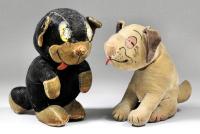 that in 1919 it was to acquire the nearby Harborne Village Institute which was used as their printing works producing box covers and labels for their toys and games. The companys’ soft toy production was relocated in 1920 to a new factory, the Wrekin Toy Works, at Wellington, Shropshire, where a new range of fabric dolls were introduced and all three factories were merged to become The Chad Valley Co. Ltd. In that same year both the Wellington and Harborne works were extended as business continued to increase.
that in 1919 it was to acquire the nearby Harborne Village Institute which was used as their printing works producing box covers and labels for their toys and games. The companys’ soft toy production was relocated in 1920 to a new factory, the Wrekin Toy Works, at Wellington, Shropshire, where a new range of fabric dolls were introduced and all three factories were merged to become The Chad Valley Co. Ltd. In that same year both the Wellington and Harborne works were extended as business continued to increase.
![]() The soft toy range they produced all carried a sew-in label, well known by collectors of today, with most reading ‘Hygienic Toys / Made in England / Chad Valley Co. or Chad Valley Co. Ltd.’ some simply ‘Hygienic Toys England’.
The soft toy range they produced all carried a sew-in label, well known by collectors of today, with most reading ‘Hygienic Toys / Made in England / Chad Valley Co. or Chad Valley Co. Ltd.’ some simply ‘Hygienic Toys England’.
In 1922 Chad Valley was a Listed Exhibitor at the British Industries Fair (Stand F.35) Indoor Games, Puzzles, 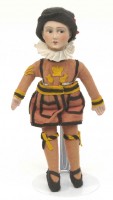 Christmas Crackers and Stockings, Toys of all Description including Playing Balls, Teddy Bears, Fabric Dolls and other Soft Toys, Rattles, Mascots etc. Interestingly enough they also featured (Stand Nos. K.35 and K.60) Listed as Manufacturers of Stationers’ Carded Sundries and Fancy Goods, Labels and Tickets, Office Appliances, Motorists’ Trunks, Fur Rugs and Gauntlets, Picnic Cases.
Christmas Crackers and Stockings, Toys of all Description including Playing Balls, Teddy Bears, Fabric Dolls and other Soft Toys, Rattles, Mascots etc. Interestingly enough they also featured (Stand Nos. K.35 and K.60) Listed as Manufacturers of Stationers’ Carded Sundries and Fancy Goods, Labels and Tickets, Office Appliances, Motorists’ Trunks, Fur Rugs and Gauntlets, Picnic Cases.
Further expansion took place again in 1928 with a new factory adjoining the main works at Harborne, and again in 1932 with the acquisition of the long established London toy making firm of Peacock & Company which added new capabilities and allowed them to offer tinplate products, including toy cars and clockwork train sets.
During the 1920’s and 1930’s the Wrekin toy works produced a steady stream of new dolls, these dolls were dressed in authentic materials and Chad Valley even brought out several boy dolls suitably attired in tweed sports jackets with felt collars, neck ties and of course the obligatory gun bag as befits the children of the country squire. It was this attention to detail which set them apart from the competition but they were not cheap, typically selling for somewhere between 5/- and 30/- which would equate to around £20 – £100 in todays money.
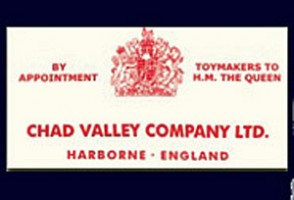 In 1938 Chad Valley were granted the prestigeous Royal Warrant of Appointment – ‘Toymakers to Her Majesty the Queen’, a relatively rare honour for a toy maker at this time. This may have had something to do with the fact that earlier in a bold move the Palace had been approached by Chad Valley executives for permission to produce dolls of the Royal Princesses, Elizabeth and Margaret Rose. It was with some surprise that the company received a note back from the Queen agreeing to the proposal along with suggested dates for the two princesses to sit for the proposed dolls. Fortunately for Chad Valley the dolls proved an instant hit, selling in large numbers not only at home but right across the then British Empire and so for the next fourteen years all Chad Valley toys carried the words ‘Toymakers to H.M. The Queen’. This was later amended to ‘Toymakers to H.M. Queen Elizabeth the Queen Mother’ when Princess Elizabeth acceded to the throne in 1952.
In 1938 Chad Valley were granted the prestigeous Royal Warrant of Appointment – ‘Toymakers to Her Majesty the Queen’, a relatively rare honour for a toy maker at this time. This may have had something to do with the fact that earlier in a bold move the Palace had been approached by Chad Valley executives for permission to produce dolls of the Royal Princesses, Elizabeth and Margaret Rose. It was with some surprise that the company received a note back from the Queen agreeing to the proposal along with suggested dates for the two princesses to sit for the proposed dolls. Fortunately for Chad Valley the dolls proved an instant hit, selling in large numbers not only at home but right across the then British Empire and so for the next fourteen years all Chad Valley toys carried the words ‘Toymakers to H.M. The Queen’. This was later amended to ‘Toymakers to H.M. Queen Elizabeth the Queen Mother’ when Princess Elizabeth acceded to the throne in 1952.
Around the 1939-1940 period Chad Valley acquired the tooling of tinplate toymakers 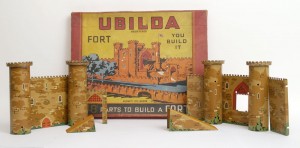 Burnett of London who had got into financial difficulties and continued to manufacture many of that companys product lines well after the second world war probably the most well know of which was the ‘Ubilda’ tinplate model kits.
Burnett of London who had got into financial difficulties and continued to manufacture many of that companys product lines well after the second world war probably the most well know of which was the ‘Ubilda’ tinplate model kits.
War, sadly again, played a part in the fortunes of the company in the 1940’s. The Second World War resulted in production of toys being dramatically cut as the Chad Valley factories concentrated their output to the war effort with government contracts for the production of such items as wooden instrument cases and cases for use in anti-aircraft guns, hospital tables and tent poles, auto-pilots and charts. However one factory was retained by the government for toy manufacture, specialising in the production of jigsaws, chess sets, draughts and dominoes for use in military hospitals and the Forces generally.
With the ending of the war the Chad Valley factories quickly returned to toy production and the company went from strength to strength adding both metal and rubber toys to their range. In 1950 it stopped being a family business and became a public limited company.
Over the next ten years or so they go on to expand by acquiring several companies including in 1951 the metal toy manufacturers of Hall and Lane, in 1954 the family business of Robert Brothers (Gloucester) Ltd., trading as ‘Glevum’ Toys and in 1958 the metal toy makers Acme Stopper and Box Co. The Glevum range of toys and games were to be produced in Harborne at an additionally factory, the Wee-Kin Works, on the banks of the Chad. By 1960 Chad Valley comprised seven factories and employed over 1,000 people and was considered to be at its peak of manufacturing by this time.
H.G. Stone and Co. Ltd. ( Chiltern Toys ) was the final company to be taken over in 1967 despite Chad Valley beginning to feel the onset of stiff foreign competition and recession.
1971 saw the company sold to John Bentley of Barclay Securities for £600,000 who came with the reputation of streamlining and rationalising companies under his control. Within a year the sales catalogue now lists only 250 products half of which were new lines whilst the remainder had been updated and repackaged. The main Harborne factory closes and was eventually demolished and boxed game production moves to the Hall & Lane factory site in central Birmingham. Three out of the nine factories are to close with the resultant redundancies.
After 1975 only two factories remained whilst the manufacture of soft toys was relocated to Pontypool in South Wales.
In 1978 the company was taken over by Palitoy of Leicester and a year later in 1979 the closure of the Hall & Lane site ended Chad Valley’s long established links with Birmingham.
In 1988 the trade name of Chad Valley was acquired by Woolworths and remained in use until that company’s closure due to insolvency. Home Retail Group, the parent company of retailers Homebase and Argos, purchased the brand for a reputed £5 million in 2009. The Chad Valley brand is now available exclusively through Argos catalogues.
____
further examples of Chad Valley toys :
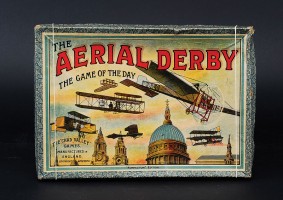 < THE AERIAL DERBY
< THE AERIAL DERBY
An excellently illustrated Chad Valley boxed board game manufactured c1912. The object of the game was to move, by means of a spinning dice, around the board starting at London and finishing at Windsor Castle travelling via such places and cities as Dublin, Montreal, Paris, Japan and New Zealand. Board has lovely illustrations of the sights of London and other cities and counters are in the form of early Bleriot type aircraft.
.
RACE TO THE OCEAN COAST >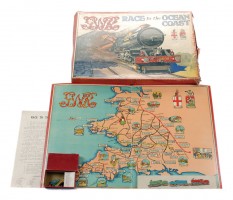
Dating to around the 1920’s is this Chad Valley GWR railway racing board game. An attractively illustrated board showing a map of Great Western railway tracks covering the West Country and Wales. Various metal locomotive and saloon car counters compete in this race to the coast.
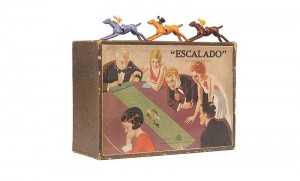
< ESCALADO
Without doubt the table top horse racing game of Escalado was one of those iconic games produced by Chad Valley. Introduced in 1928 the game was a constant best seller well into the 1960’s. Originally consisted of 5 lead race horses with jockeys, a green cloth fabric track with clamps and a mechanical winding mechanism along with a staking sheet on which one placed ones bets. Over the years the illustrated box top changed and reflected the decade, opposite shows a pre-war box lid.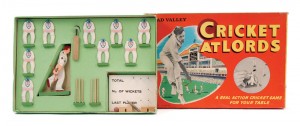
CRICKET AT LORDS >
Originally dating to the late 1940’s this Chad Valley game is a complete miniature table top game of cricket. Contains a bat, ball, pair of stumps, scoreboard and numbers, 9 fielders and a firing action bowler. The bowler figure is used by one player to toss a wooden ball at the wickets whilst the other player attempts to hit the ball into play avoiding the wooden fielders. Shown here is an illustration of the 1950’s version of the game.
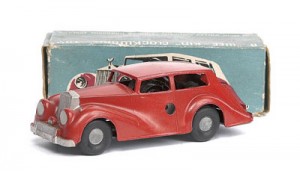 .
.
< RAZOR EDGE ROLLS ROYCE SALOON
Chad Valley ‘Wee-Kin’ motorised toy model of a Rolls Royce Razor Edge Saloon car. Diecast vehicle fitted with a key-wound clockwork motor produced between 1949-1953. Model came in various colouways in a card illustrated box at 1:43 scale.
.
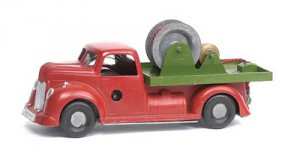
.
CABLE LAYER LORRY >
This Chad Valley clockwork driven toy comes as a cable laying vehicle, again produced around 1949 – 1953. Lorry came in red cab and chassis colourway finish with green bed mounted with a cable drum, coloured string acting as the cable.
.
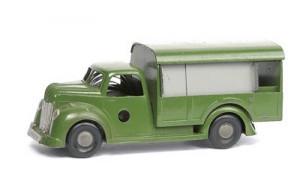 < VAN TYPE REFUSE WAGON
< VAN TYPE REFUSE WAGON
Wee-Kin van type refuse wagon, diecast clockwork model in van type configuration has green cab and body and fitted with grey tinplate sliding shutters. Again produced between 1949 – 1953.
Note : The first Wee-Kin diecast toy vehicles were produced around 1949 and had ‘CV 1949’ as the registration number.
I hope to cover the ‘Wee-Kin’ element of the Chad Valley range in more detail at a later date along with further images.
